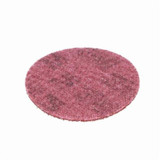3M™ 7000045943
SC-BS Backstand File Scrim Surface Conditioning Non-Woven Abrasive Belt, 1/2 in W x 24 in L, Medium Grade, Aluminum Oxide Abrasive, Maroon
- BIPN:
- MMM-48011-03998
- UPC:
- 48011039985
- Availability:
- Typically Ships in 1 to 7 Days
- Quantity Interval:
- 1 / EA - Each
-
Scotch-Brite™ Non-Woven Abrasive Belt, Backstand File Scrim Surface Conditioning, 24 in Belt Length, 1/2 in Belt Width, Medium Grade, Aluminum Oxide Abrasive, Maroon, Applicable Materials: All Metals
Scotch-Brite™ SC surface conditioning belt is a durable belt engineered to perform detail work such as blending, blending corners, cleaning, contour finishing, deburring, deburring edges, fine finishing, flat finishing, setting the grain, stainless steel finishing and attaining straight line brushed finishes on a variety of metals. Scotch-Brite™ SC surface conditioning belts work well to remove coarse grindlines, mill marks or small burrs left by cutting tools or conventional abrasives. Abrasive belts come in many different widths and lengths and are used on a variety of different belt sanding tools for many different applications on both wood and metal. Choose right belt for you at 3M™ we offer a broad selection of belts to fit most any industrial belt sander. Wide belt sanders are used for sanding and finishing large wood panels. Medium width belts fit onto edge or portable belt sanders for sanding or blending wood pieces such as cabinet doors and narrow belts are used with file tools in metalworking to access small areas or inside corners. Scotch-Brite™ SC surface conditioning belts with a choice of silicon carbide or aluminum oxide abrasive mineral. Silicon carbide is a synthetic mineral that is very sharp and commonly used for low pressure applications such as paint prep and finishing. Aluminum oxide is a hard, blocky mineral that provides high cut rate and long life. While silicon carbide breaks down faster than aluminum oxide, it produces a finer finish Belt sanders are used for rapid grinding, sanding and finishing on a variety of surfaces. Depending on the material being worked, sanding wheels and discs may clog, quickly making them less efficient, while belt sanders continue to sand without clogging because small grooves in the abrasive belt open as they go around the arc of the drive wheel.
-
- Abrasive Material Aluminum Oxide
- Applicable Materials All Metals
- Belt Length 24 in
- Belt Width 1/2 in
- Color Maroon
- Grade Medium
- Series SC-BS
- Type Backstand File Scrim Surface Conditioning
-
- Non-woven, surface conditioning belts clean, blend, deburr and finish
- Reduced loading and heat build-up allow extended operating time and consistent surface conditioning results
- Reinforced backing and non-woven open web material provides superior flexibility for detail work, over contours and edges
- Removes surface imperfections, grindlines, mill and other marks
- Primary applications are metal working paint prep, coating and corrosion removal
- Backstand file belt sanders, inline sanders are equipment machines
- Used in builders hardware, medical instruments, metal fabrication, metal implants, plumbing fixtures, turbine engines industries











